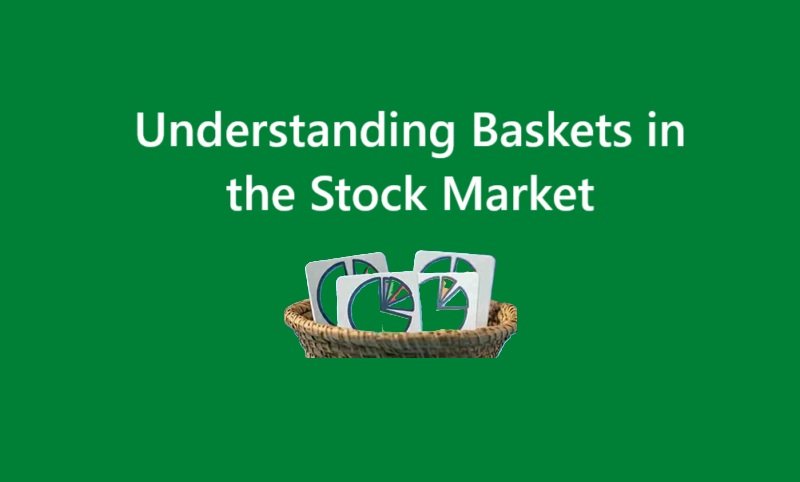
Investing in the stock market can be confusing, especially with all the terms and concepts involved. One such term is baskets. In simple words, a basket in the stock market refers to a group of stocks, bonds, or other financial assets that are bundled together for investment purposes. This concept allows investors to invest in multiple assets at once, rather than buying each one individually.
What Is a Basket in the Stock Market?
A basket is a collection of financial assets, such as stocks, that are grouped together and treated as a single unit. These baskets are often created based on certain themes, industries, or strategies. For example, a basket might include stocks from the technology sector, or it could focus on companies with high growth potential.
Why Are Baskets Used?
Baskets simplify the process of investing by allowing investors to diversify their portfolio without needing to buy each asset separately. Here are some reasons why baskets are popular:
- Diversification: A basket spreads your investment across several assets, reducing the risk of losing money if one stock performs poorly.
- Ease of Investment: Instead of researching and buying individual stocks, you can invest in a basket that aligns with your goals.
- Cost-Effective: Buying a basket may save on transaction costs compared to purchasing multiple stocks individually.
- Focus on Themes: Baskets let you invest in specific industries, sectors, or strategies easily.
Types of Baskets in the Market
- Sector Baskets:
- These include stocks from a specific industry or sector, such as technology, healthcare, or finance.
- Example: A technology basket might include stocks of companies like TCS, Infosys, and HCL.
- Thematic Baskets:
- These focus on specific themes like green energy, artificial intelligence, or consumer goods.
- Example: A renewable energy basket could include companies involved in solar and wind energy projects.
- Index Baskets:
- These replicate popular stock market indices like the Nifty 50 or S&P 500.
- Example: An index basket for Nifty 50 would include all the stocks that are part of the Nifty 50 index.
- Custom Baskets:
- Investors or fund managers can create their own baskets by selecting specific assets based on their preferences.
- Example: A custom basket might include stocks from various sectors that align with an investor’s personal goals.
How Are Baskets Used?
- Exchange-Traded Funds (ETFs): Many baskets are packaged as ETFs, which are traded on stock exchanges like individual stocks. For instance, an ETF for the banking sector is essentially a basket of banking stocks.
- Mutual Funds: Mutual funds often operate like baskets, pooling money from investors to buy a range of assets.
- Portfolio Management: Financial advisors or investment platforms often offer pre-made baskets based on risk levels, such as aggressive, balanced, or conservative portfolios.
Advantages of Investing in Baskets
- Reduces Risk: Since your investment is spread across multiple assets, the impact of one poorly performing stock is minimized.
- Time-Saving: You don’t need to research and monitor each individual stock.
- Affordable Diversification: Baskets allow you to diversify your portfolio without needing a large amount of money.
- Tailored to Goals: Many baskets are designed to match specific investment goals or strategies.
Challenges and Risks of Baskets
- Limited Control: When you invest in a basket, you don’t control the selection of individual stocks.
- Fees and Costs: Some baskets, especially mutual funds or ETFs, may have management fees.
- Market Risk: While baskets reduce risk from individual stocks, they are still affected by overall market trends.
- Over-Diversification: If a basket includes too many assets, it might dilute potential gains.
Who Should Invest in Baskets?
Baskets are a good option for:
- Beginners: New investors who want to start with a simple and diversified approach.
- Busy Investors: People who don’t have time to research individual stocks.
- Risk-Averse Investors: Those looking to reduce risk by spreading investments.
- Goal-Oriented Investors: People focusing on specific themes or sectors.
How to Invest in Baskets?
- Through ETFs: Look for ETFs that match your investment goals.
- Using Mutual Funds: Invest in mutual funds that represent specific sectors or indices.
- Online Platforms: Many investment platforms offer pre-made baskets based on themes or risk levels.
- Custom Creation: If you’re experienced, create your own basket by selecting stocks manually.
Conclusion
Baskets in the stock market make investing easier and less risky by grouping multiple assets together. They are a great choice for both new and experienced investors, offering diversification, simplicity, and a focus on specific goals. Whether you invest through ETFs, mutual funds, or custom portfolios, baskets provide a flexible way to grow your money while managing risks effectively.





